A Modelling and Validation Approach for Predicting Particle Concentrations of Airborne Dust during the Filling Process of Cylindrical Silos
Abstract
1. Introduction
2. Material and Methods
2.1. Experiment Setup
2.2. Materials
2.3. Simulation Overview
2.4. Simulation Parameters
2.5. Challenges of Comparing Simulations to Experiments
3. Results and Discussion
3.1. Experimental Results
3.2. Comparing Simulations to Experiments
- The 220 mm plane contains both the CW and CH values, as this is where the laser sheet intensity is greatest. The simulation results compare the nodes at 219.06 mm and 224.04 mm (as shown in Figure 17); this is due to the previously mentioned effects of node averaging.
- The X and Z coordinates for these nodes can be compressed into a 2D line by considering their polar coordinates.
4. Conclusions and Future Work
- Simulation data is extracted at the 220 mm plane; a plane above at 320 mm and a plane below at 120 mm.
- The CW value is found at 2 mm away from the silo wall for each plane.
- A CH value is calculated using CW/CRF for each plane.
- The CH values are compared. If the simulation is calibrated correctly then the 220 mm plane should contain the largest CH value.
- -
- Measure the particle mass concentration close to the silo wall (2 mm) in the experiments and apply the CRF value to this concentration.
- -
- Running experiments at a reduced scale to identify how the ratio scales.
- -
- Extend the simulation duration to improve the average results i.e., a more representative sample due to a larger data set.
Author Contributions
Funding
Institutional Review Board Statement
Informed Consent Statement
Data Availability Statement
Conflicts of Interest
References
- Carbo, M.C.; Abelha, P.M.R.; Cieplik, M.K.; Mourão, C.; Kiel, J.H.A. Fuel pre-processing, pre-treatment and storage for co-firing of biomass and coal. In Fuel Flexible Energy Generation: Solid, Liquid and Gaseous Fuels; Woodhead Publishing: Sawston, UK, 2015; pp. 121–143. [Google Scholar]
- Eckhoff, R.K.; Randeberg, E. Electrostatic spark ignition of sensitive dust clouds of MIE<1 mJ. J. Loss. Prevent. Proc. 2007, 20, 396–401. [Google Scholar] [CrossRef]
- Zigan, S.; Thorpe, R.B.; Tuzun, U.; Enstad, G.G.; Battistin, F. Theoretical and experimental testing of a scaling rule for air current segregation of alumina powder in cylindrical silos. Powder Technol. 2008, 183, 133–145. [Google Scholar] [CrossRef]
- Cleary, P.W.; Hilton, J.E.; Sinnott, M.D. Modelling of industrial particle and multiphase flows. Powder Technol. 2017, 314, 232–252. [Google Scholar] [CrossRef]
- Chen, X.L.; Wheeler, C.A.; Donohue, T.J.; McLean, R.; Roberts, A.W. Evaluation of dust emissions from conveyor transfer chutes using experimental and CFD simulation. Int. J. Miner. Process. 2012, 110–111, 101–108. [Google Scholar] [CrossRef]
- Wang, Y.; Jiang, Z.; Chen, J.; Chen, J.; Wang, M. Study of high-pressure air curtain and combined dedusting of gas water spray in multilevel ore pass based on CFD-DEM. Adv. Powder Technol. 2019, 30, 1789–1804. [Google Scholar] [CrossRef]
- Geng, F.; Luo, G.; Wang, Y.; Peng, Z.; Hu, S.; Zhang, T.; Chai, H. Dust dispersion in a coal roadway driven by a hybrid ventilation system: A numerical study. Process Saf. Environ. 2018, 113, 388–400. [Google Scholar] [CrossRef]
- Sun, B.; Cheng, W.; Wang, J.; Wang, H. Effects of turbulent airflow from coal cutting on pollution characteristics of coal dust in fully-mechanized mining face: A case study. J. Clean. Prod. 2018, 201, 308–324. [Google Scholar] [CrossRef]
- Stone, L.; Hastie, D.; Zigan, S. Using a coupled CFD—DPM approach to predict particle settling in a horizontal air stream. Adv. Powder Technol. 2019, 30, 869–878. [Google Scholar] [CrossRef]
- Rani, S.I.; Aziz, B.A.; Gimbun, J. Analysis of dust distribution in silo during axial filling using computational fluid dynamics: Assessment on dust explosion likelihood. Process Saf. Environ. 2015, 96, 14–21. [Google Scholar] [CrossRef]
- Gouesbet, G. Laser-Based Optical Measurement Techniques of Discrete Particles: A Review. Int. J. Multiph. Flow. 2015, 288–297. [Google Scholar] [CrossRef]
- Wang, Y. Experimental study of flow regimes and dust emission in a free falling particle streams. Powder Technol. 2016, 14–22. [Google Scholar] [CrossRef]
- Ansart, R.; de Ryck, A.; Dodds, J.A.; Roudet, M.; Fabre, D.; Charru, F. Dust emission by powder handling: Comparison between numerical analysis and experimental results. Powder Technol. 2009, 190, 274–281. [Google Scholar] [CrossRef]
- Smits, A.J.; Lim, T.T. Photographic Equipment and Techniques. In Flow Visualization: Techniques and Examples, 2nd ed.; Imperial College Press: London, UK, 2012; p. 66. [Google Scholar]
- Lulbadda Waduge, L.L.; Zigan, S.; Stone, L.E.; Belaidi, A.; García-Triñanes, P. Predicting concentrations of fine particles in enclosed vessels using a camera based system and CFD simulations. Process. Saf. Environ. 2017, 105, 262–273. [Google Scholar] [CrossRef]
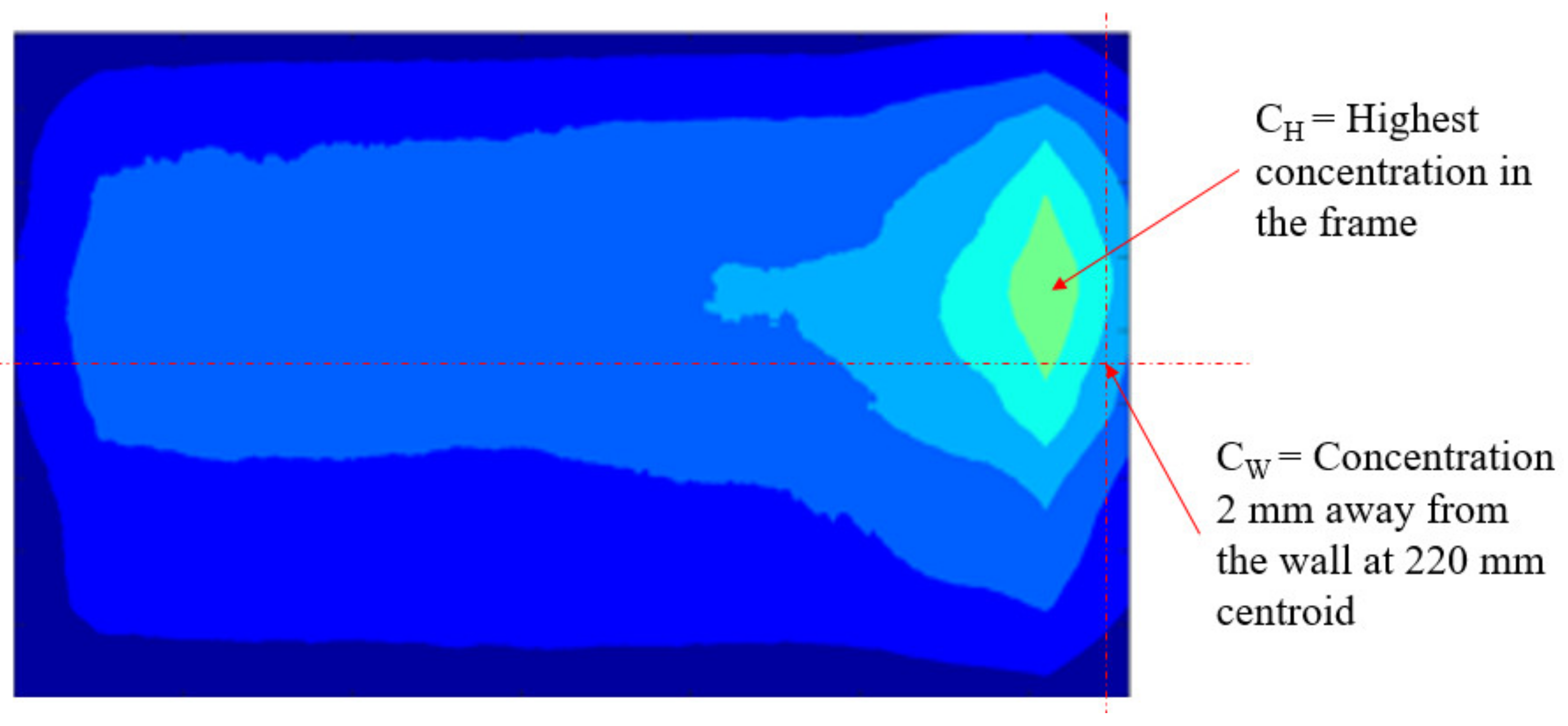
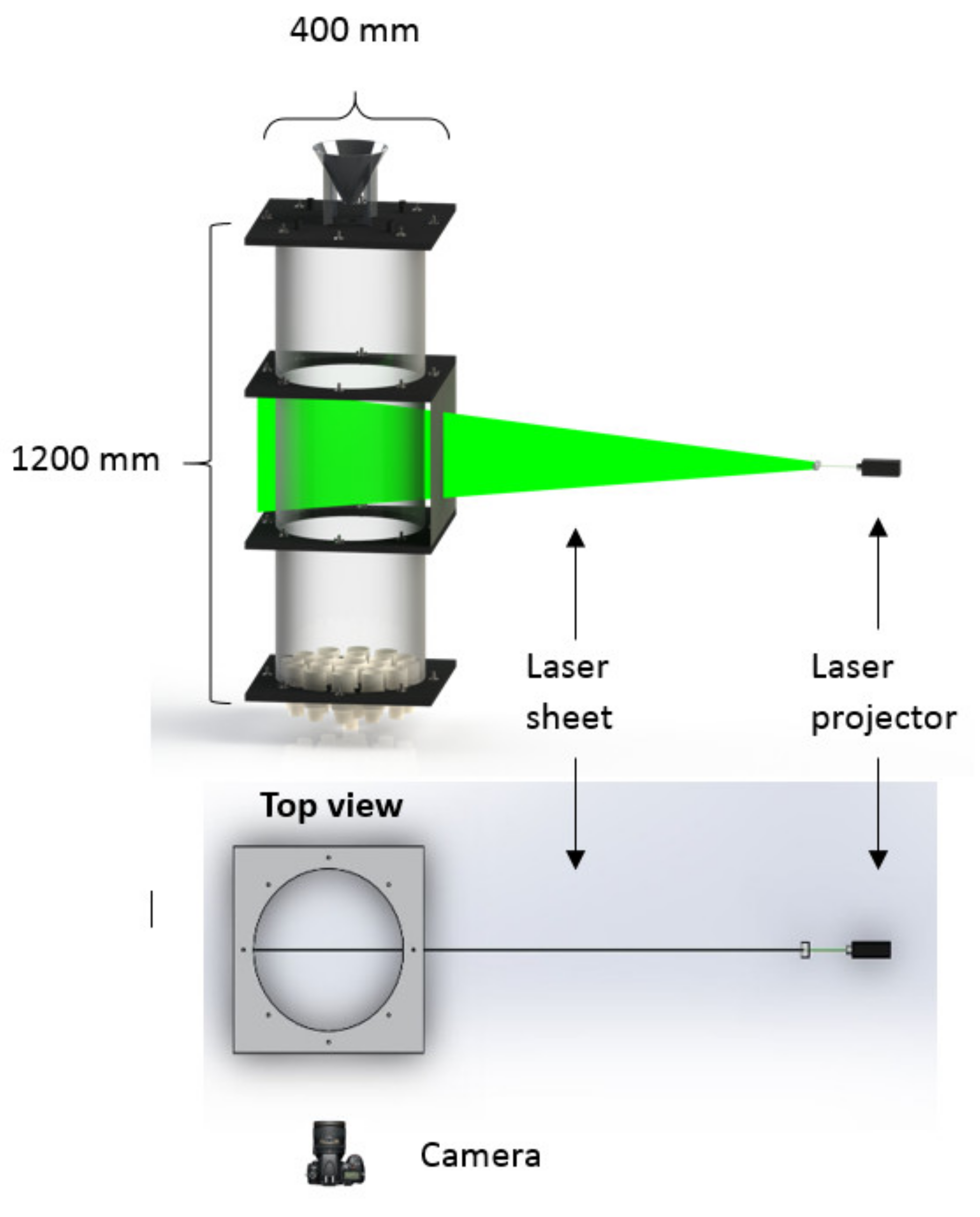
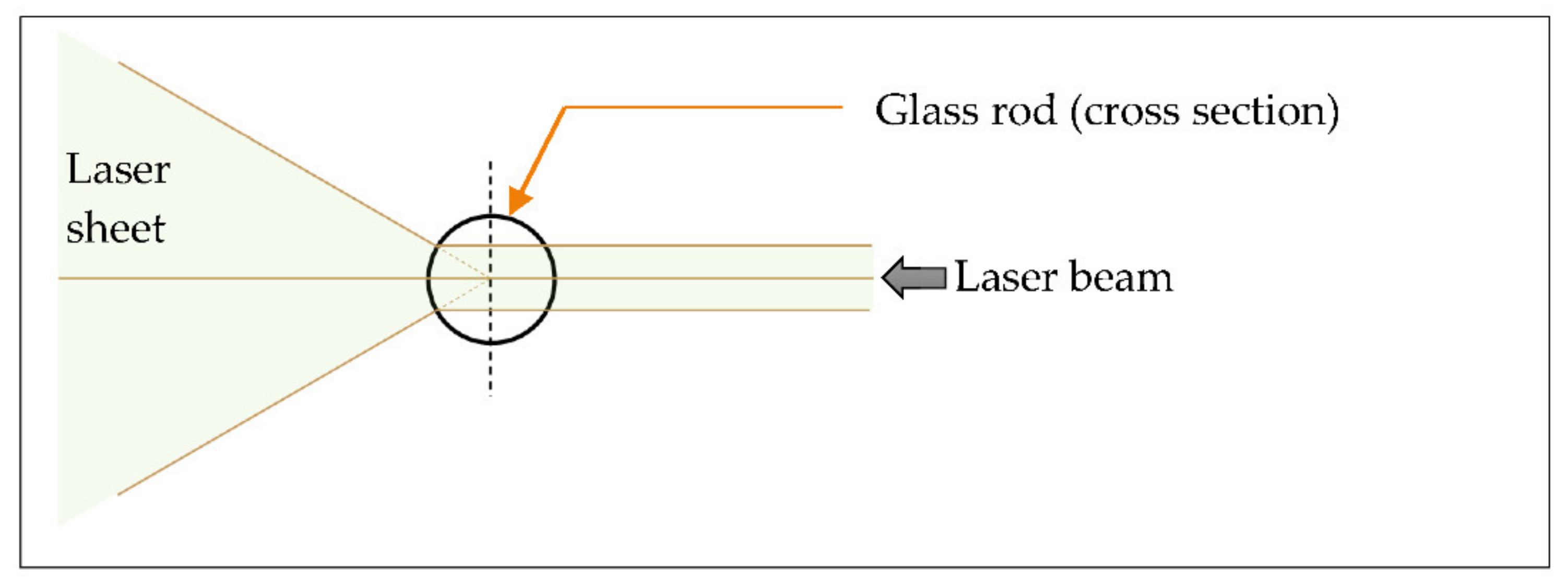
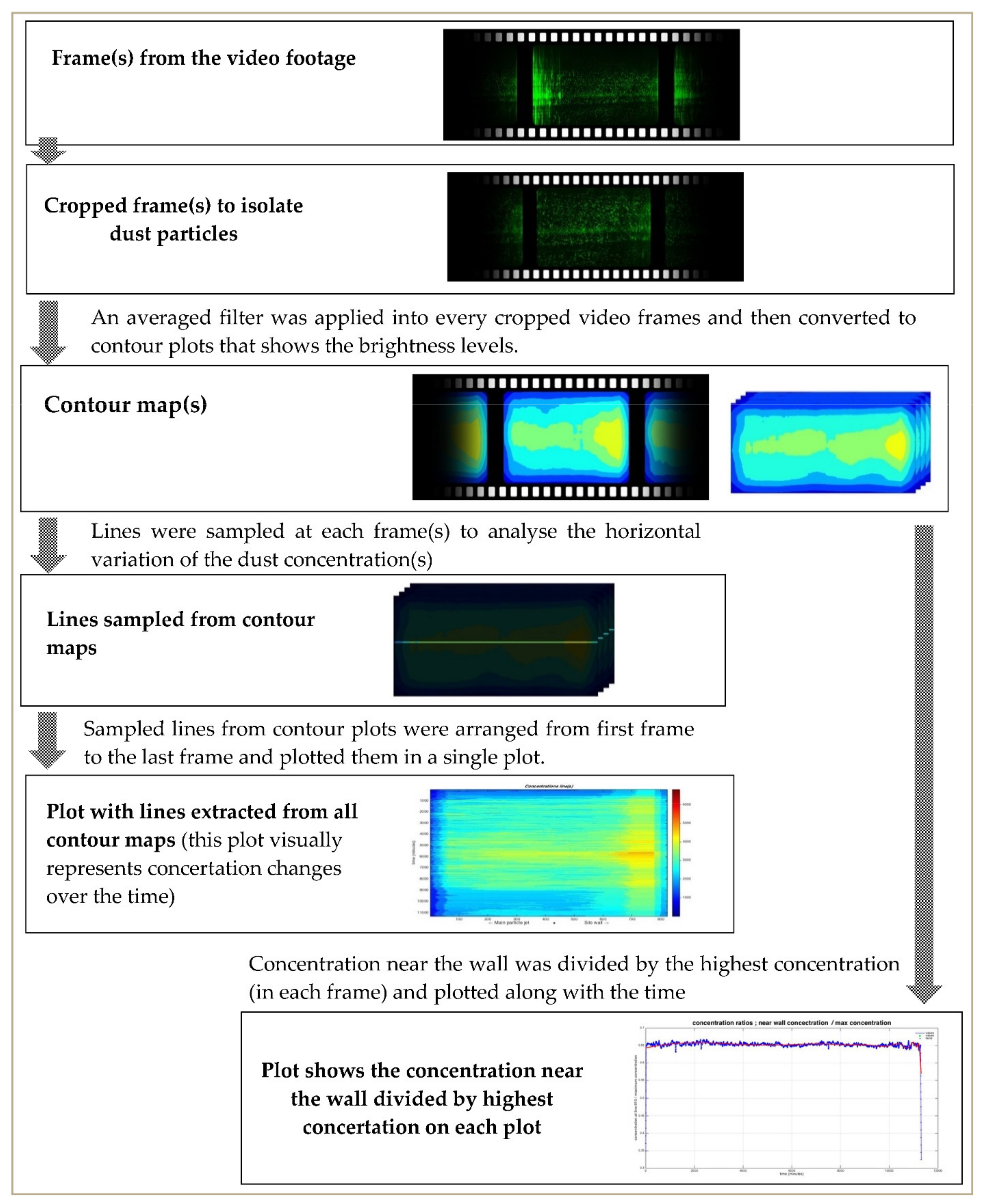
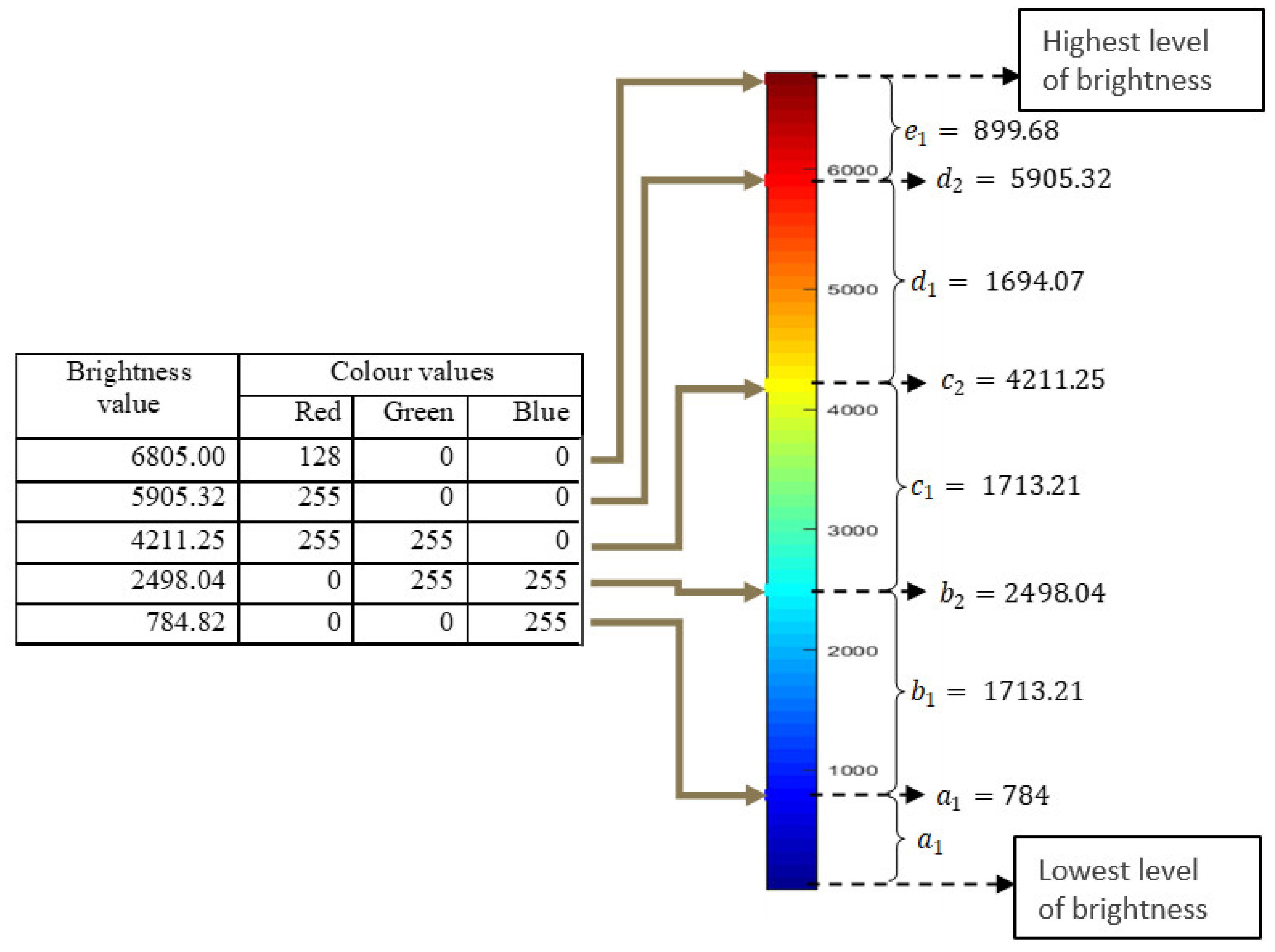
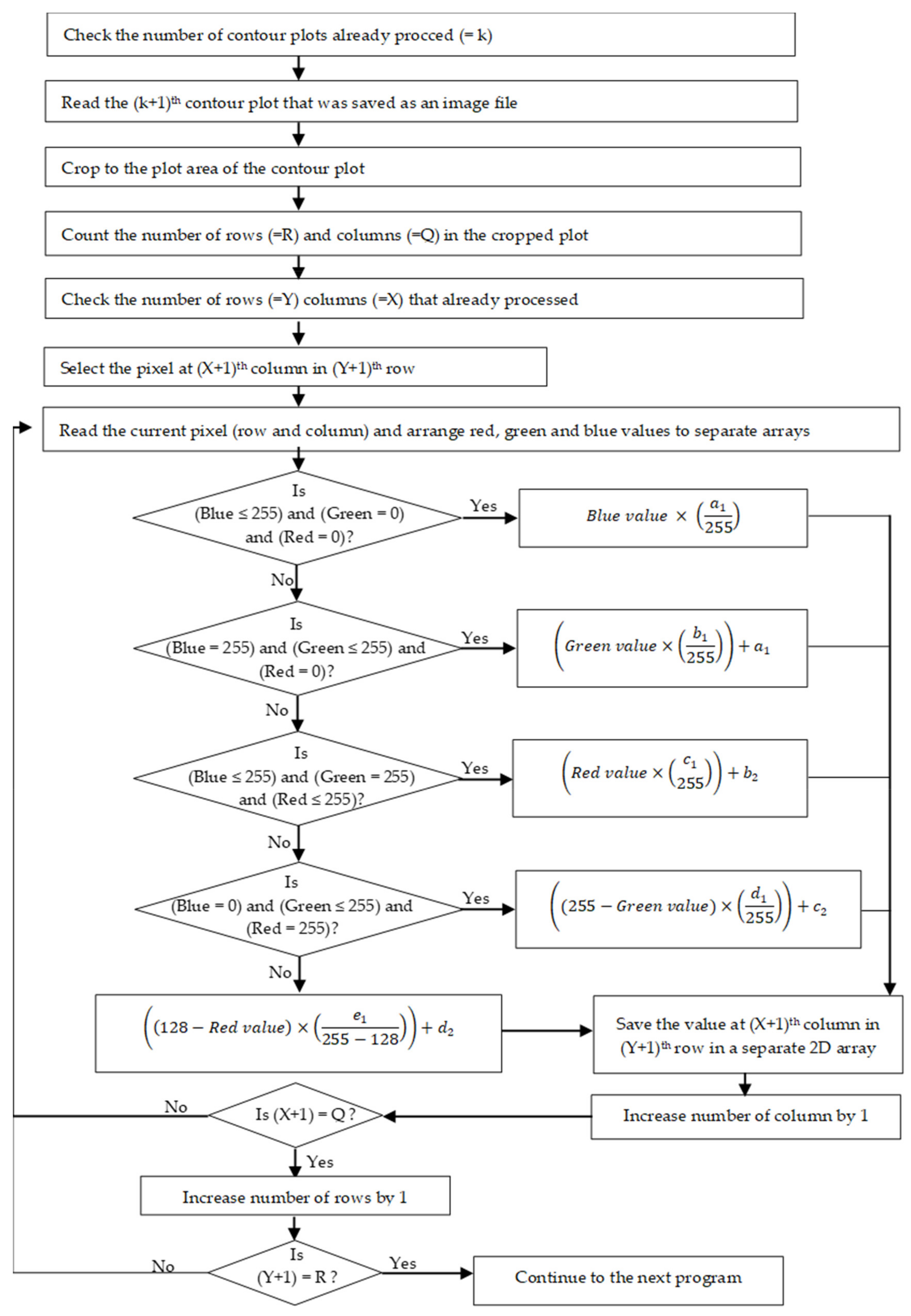
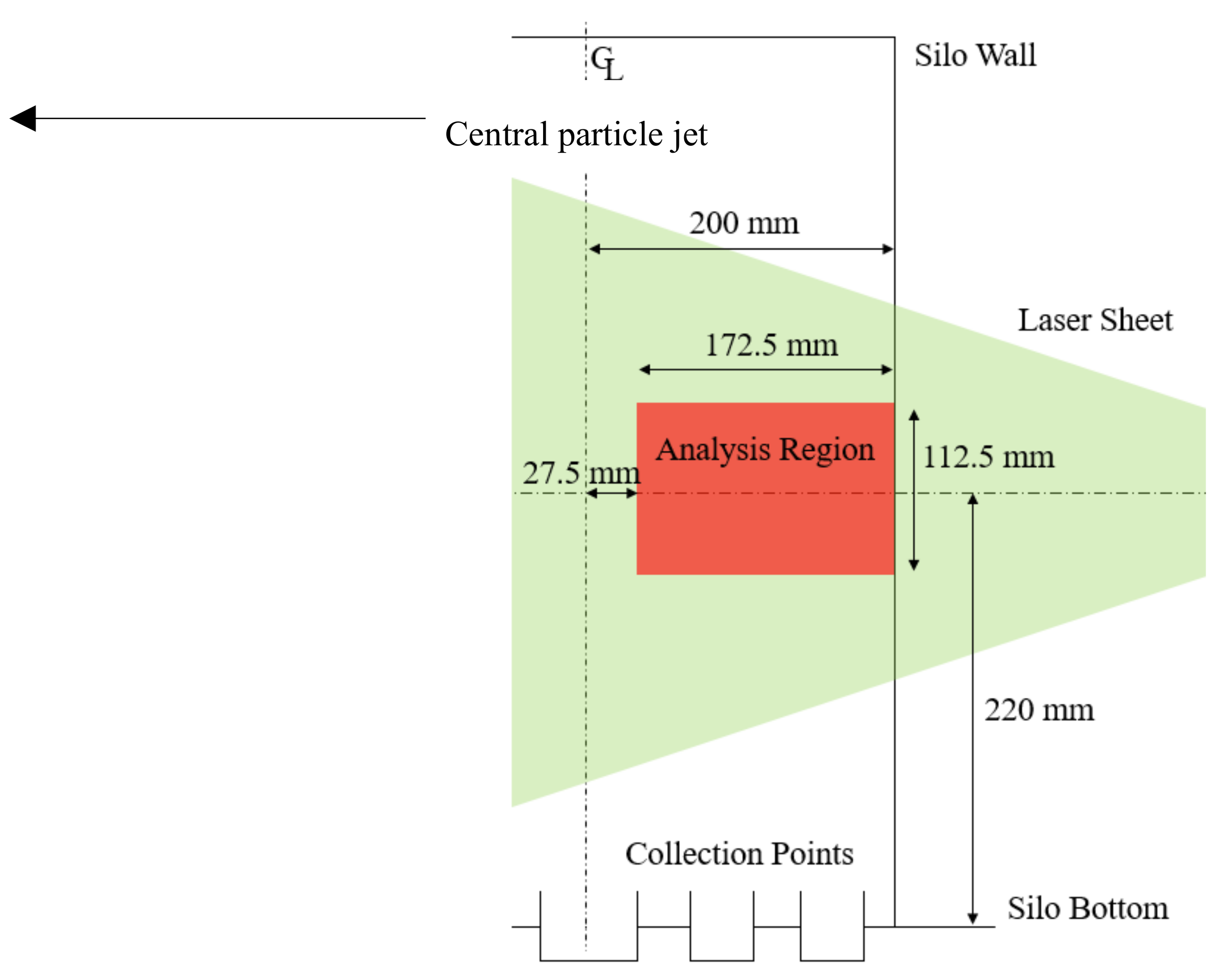

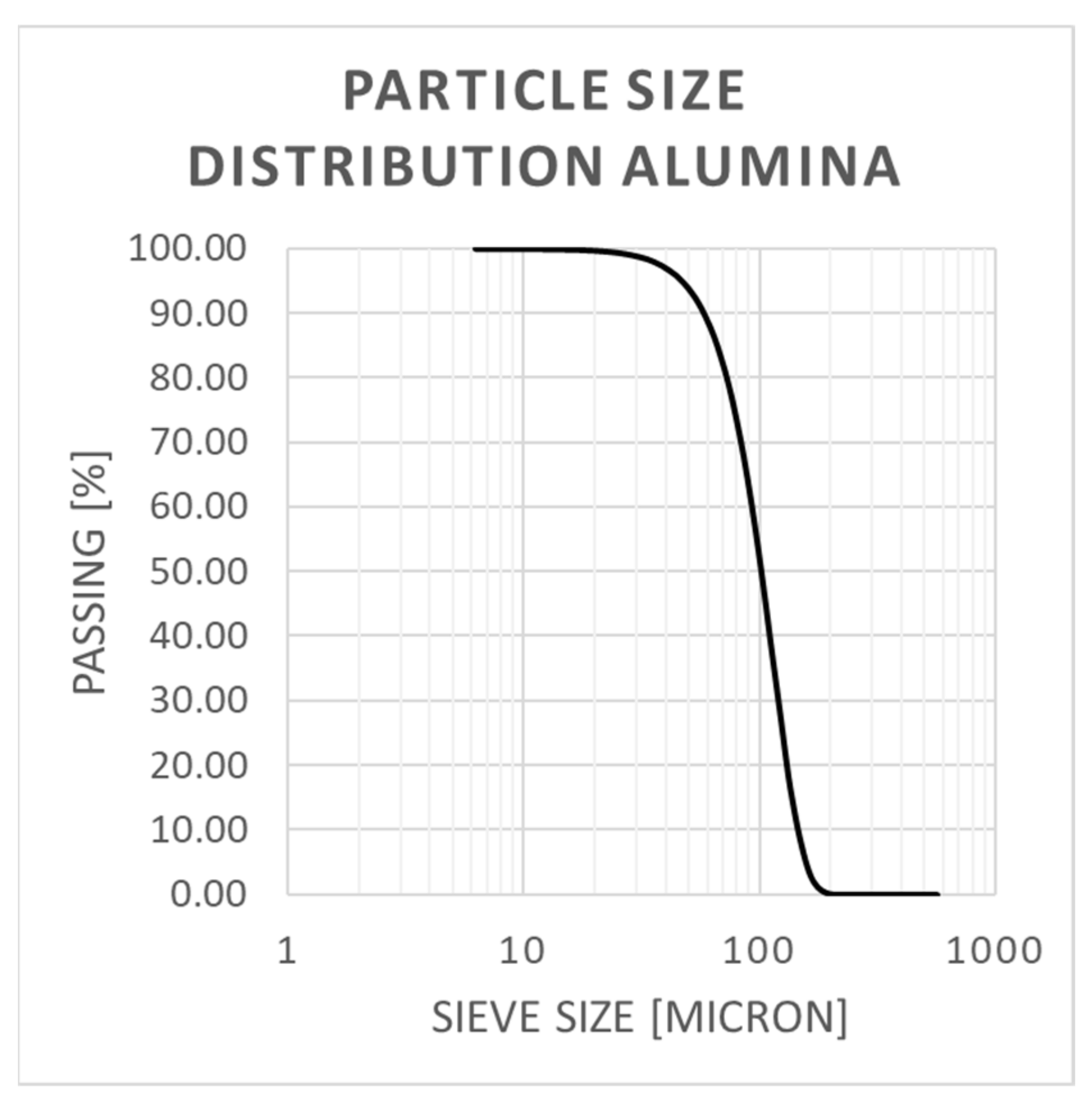
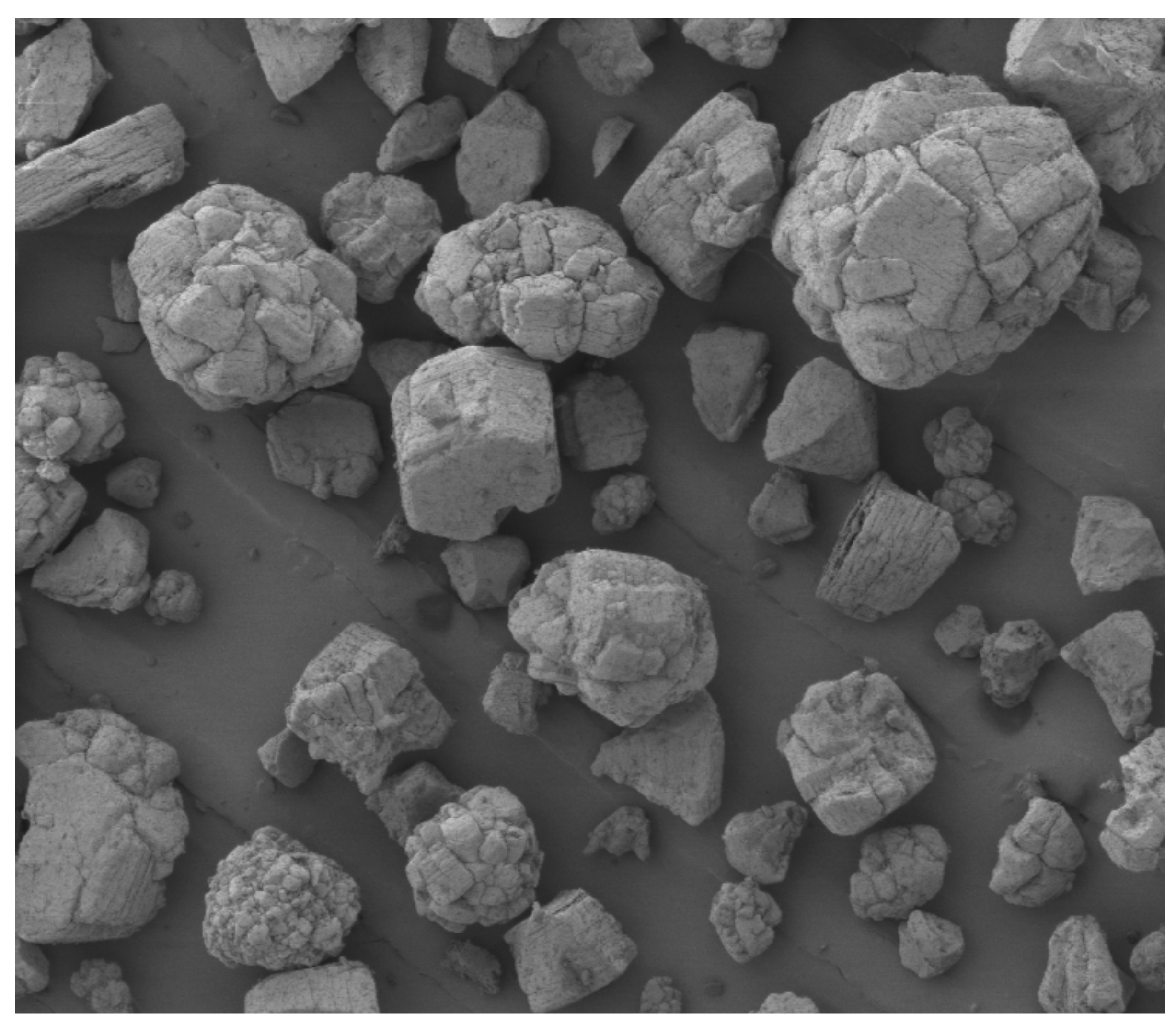


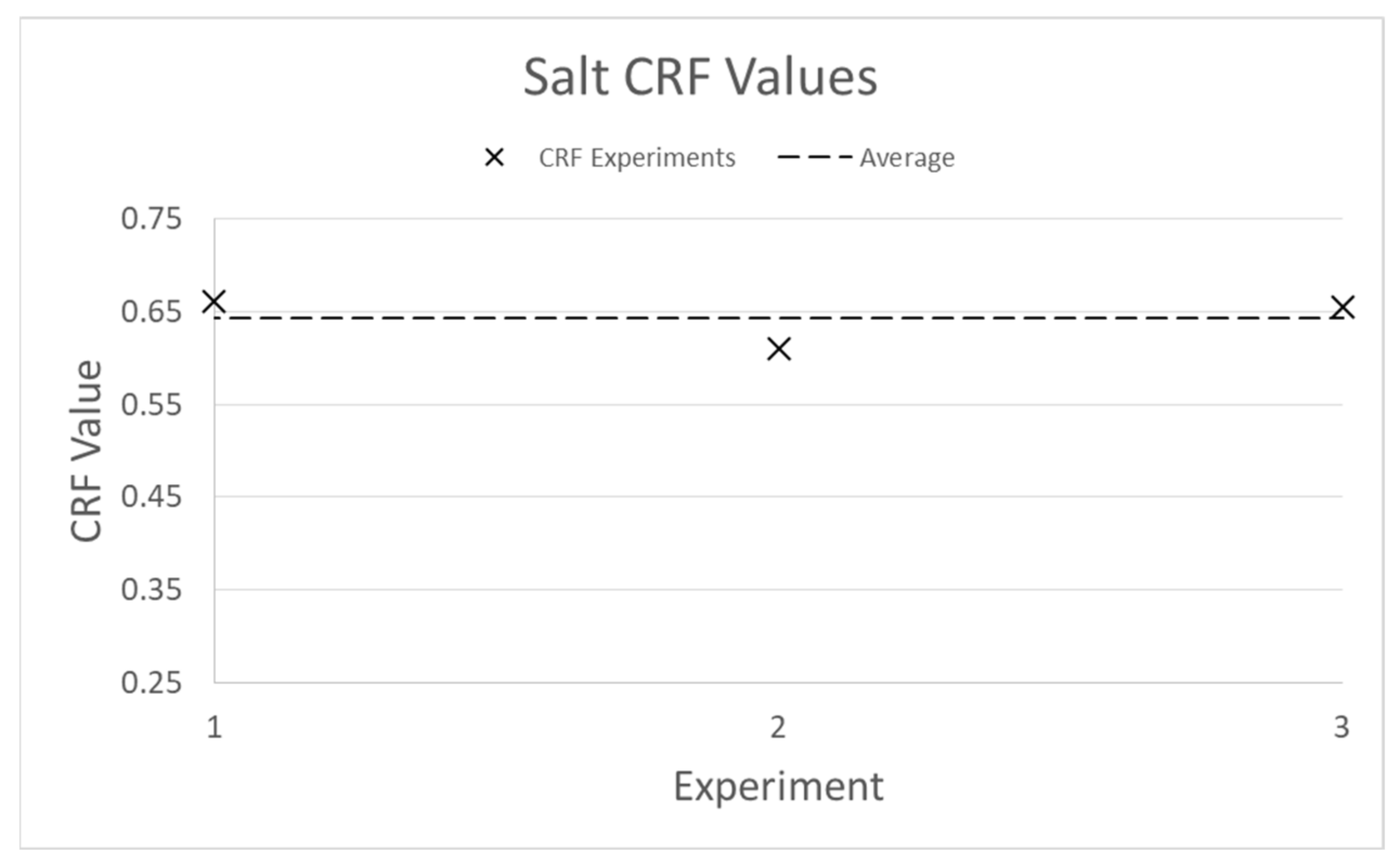

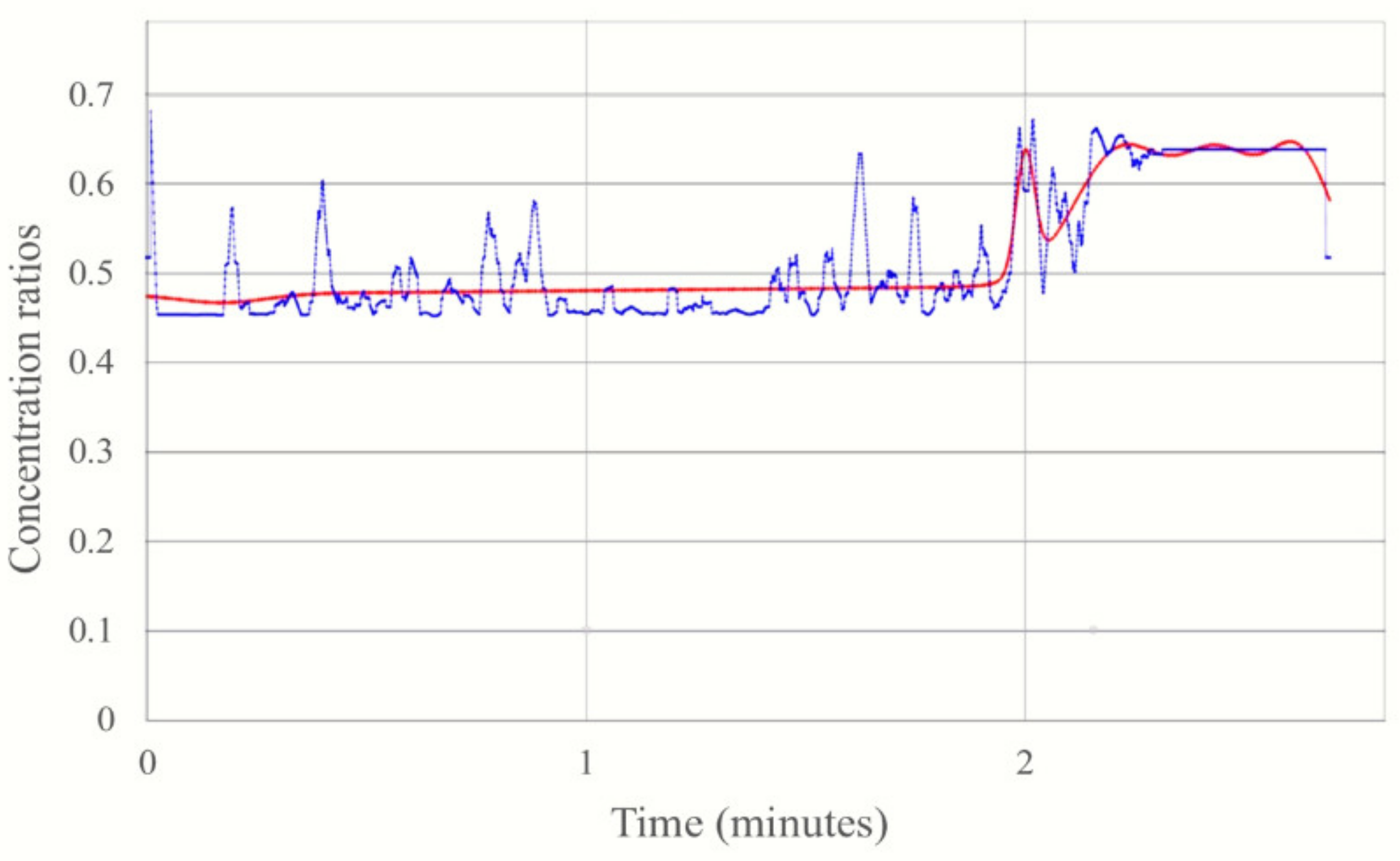

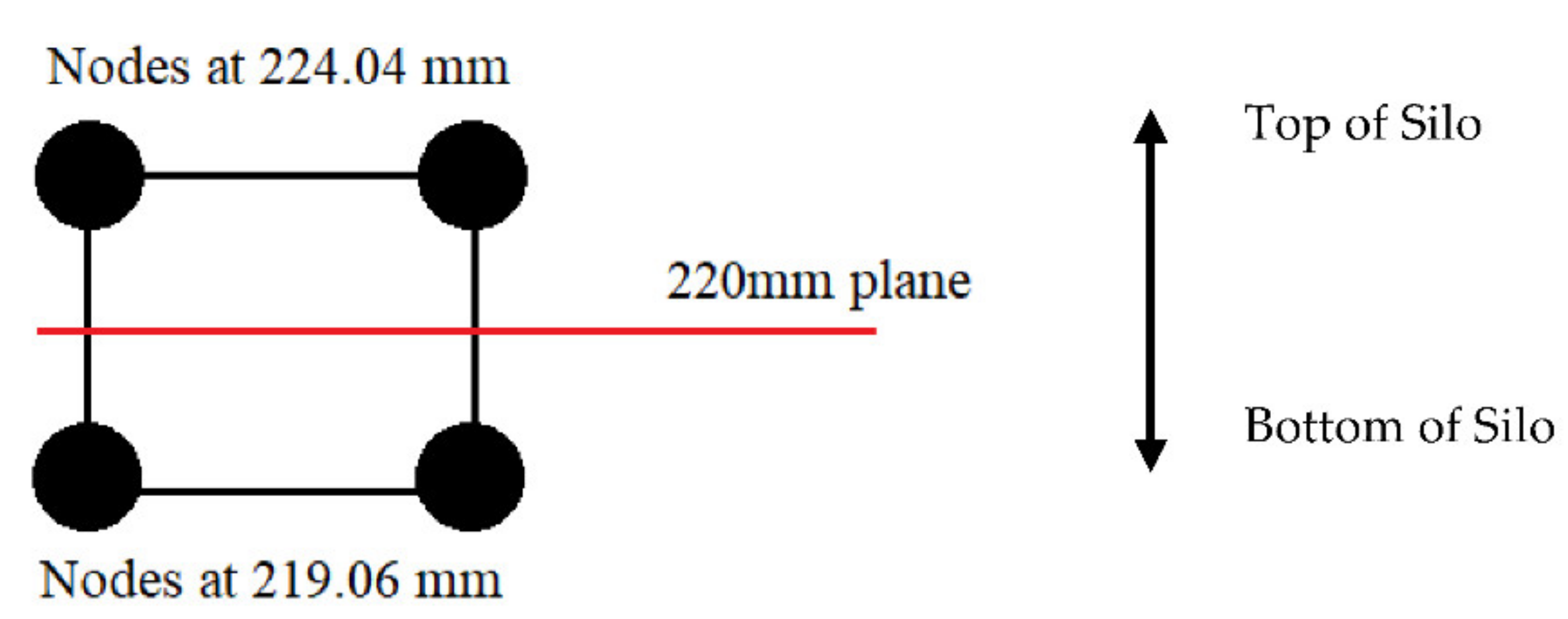


| Description | Alumina Simulation |
|---|---|
| Domain | 3D—Quarter silo |
| Turbulence model | K-epsilon realisable standard wall functions |
| Coupling | Discrete Phase Model (DPM) with two-way turbulence coupling enabled |
| Material (particle density) | alumina (3900 kg/m3) |
| PSD—fines | Rosin-Rammler distribution D min = 5.2 um D mean = 72.8 um D max = 350 um n = 1.61 |
| Mass flow rate—fines | 1.9 × 10−5 kg/s |
| PSD—coarse | Uniform distribution D = 350 um |
| Mass flow rate—coarse | 1.9 × 10−02 kg/s |
| DPM—parcels | 1 particle per parcel |
| Mesh Parameter | Value |
|---|---|
| Maximum Element Size [mm] | 8.991 |
| Capture Curvature? | Yes |
| Capture Proximity? | No |
| Quality Smoothing | High |
| Inflation; Option | Smooth Transition Ratio: 0.272 Maximum Layers: 5 Growth Rate: 1.2 |
| Assembly Meshing Method | Cut Cell |
| Elements | 320853 |
| Plane Location | CW Value [kg/m3] | CH Calculated [kg/m3] |
|---|---|---|
| 120 mm | 0.0014 | 0.0022 |
| 220 mm | 0.0021 | 0.0032 |
| 320 mm | 0.0011 | 0.0017 |
Publisher’s Note: MDPI stays neutral with regard to jurisdictional claims in published maps and institutional affiliations. |
© 2021 by the authors. Licensee MDPI, Basel, Switzerland. This article is an open access article distributed under the terms and conditions of the Creative Commons Attribution (CC BY) license (http://creativecommons.org/licenses/by/4.0/).
Share and Cite
Stone, L.; Zigan, S.; Waduge, L.L.L.; Hastie, D.B. A Modelling and Validation Approach for Predicting Particle Concentrations of Airborne Dust during the Filling Process of Cylindrical Silos. Appl. Sci. 2021, 11, 1794. https://doi.org/10.3390/app11041794
Stone L, Zigan S, Waduge LLL, Hastie DB. A Modelling and Validation Approach for Predicting Particle Concentrations of Airborne Dust during the Filling Process of Cylindrical Silos. Applied Sciences. 2021; 11(4):1794. https://doi.org/10.3390/app11041794
Chicago/Turabian StyleStone, Luke, Stefan Zigan, Lahiru L. Lulbadda Waduge, and David B. Hastie. 2021. "A Modelling and Validation Approach for Predicting Particle Concentrations of Airborne Dust during the Filling Process of Cylindrical Silos" Applied Sciences 11, no. 4: 1794. https://doi.org/10.3390/app11041794
APA StyleStone, L., Zigan, S., Waduge, L. L. L., & Hastie, D. B. (2021). A Modelling and Validation Approach for Predicting Particle Concentrations of Airborne Dust during the Filling Process of Cylindrical Silos. Applied Sciences, 11(4), 1794. https://doi.org/10.3390/app11041794






